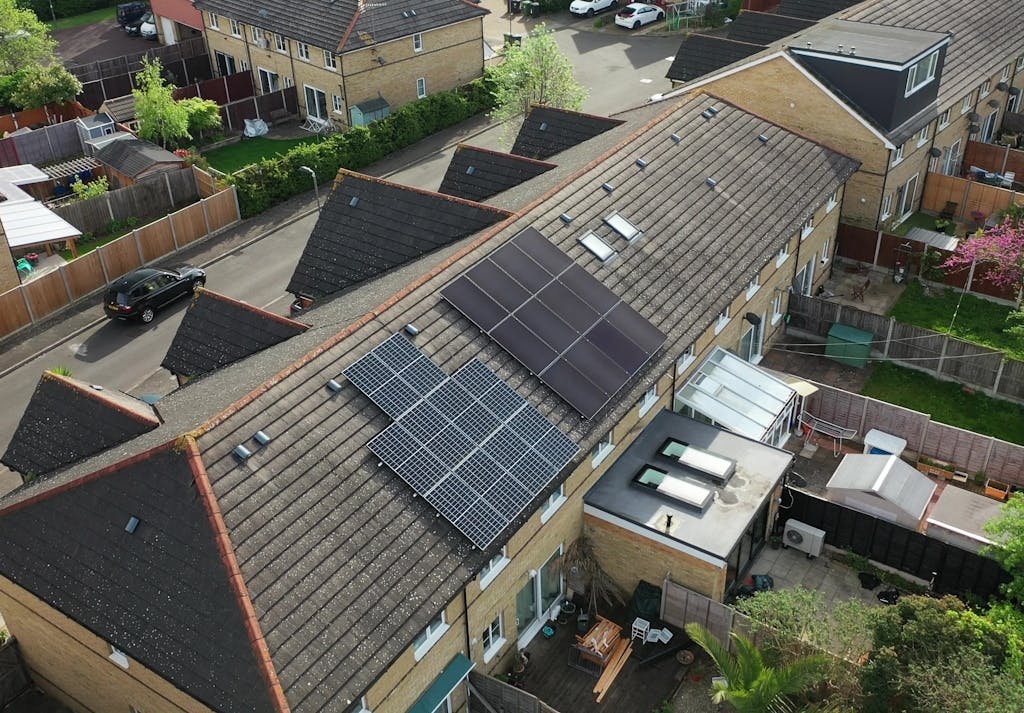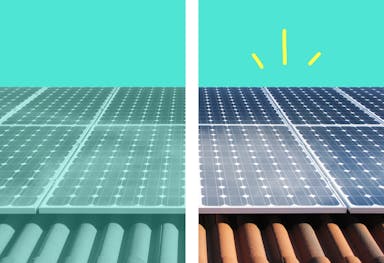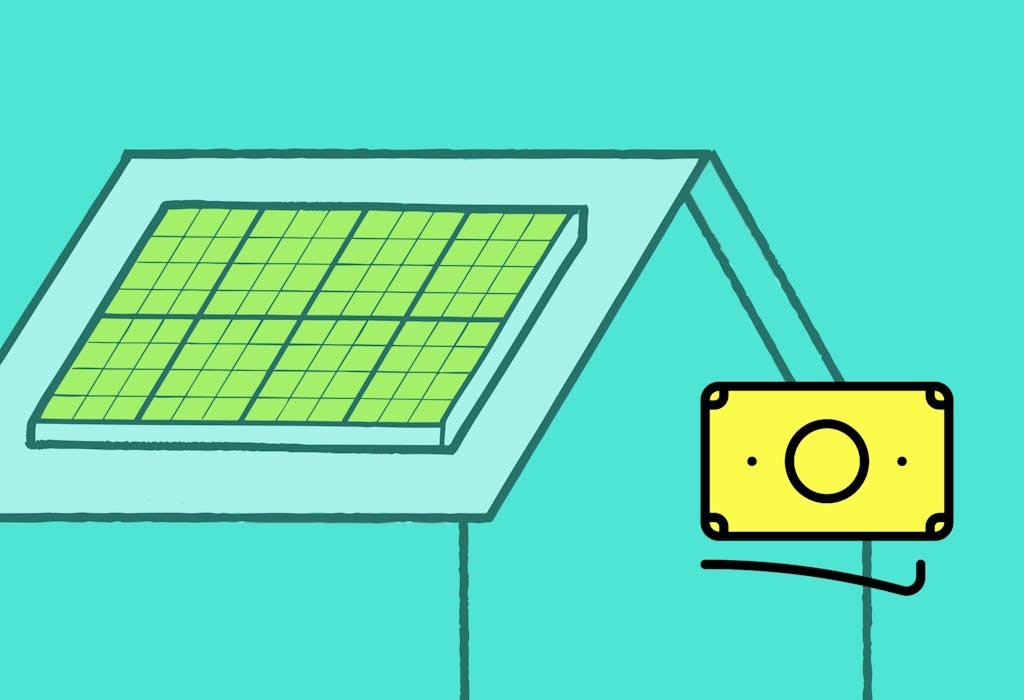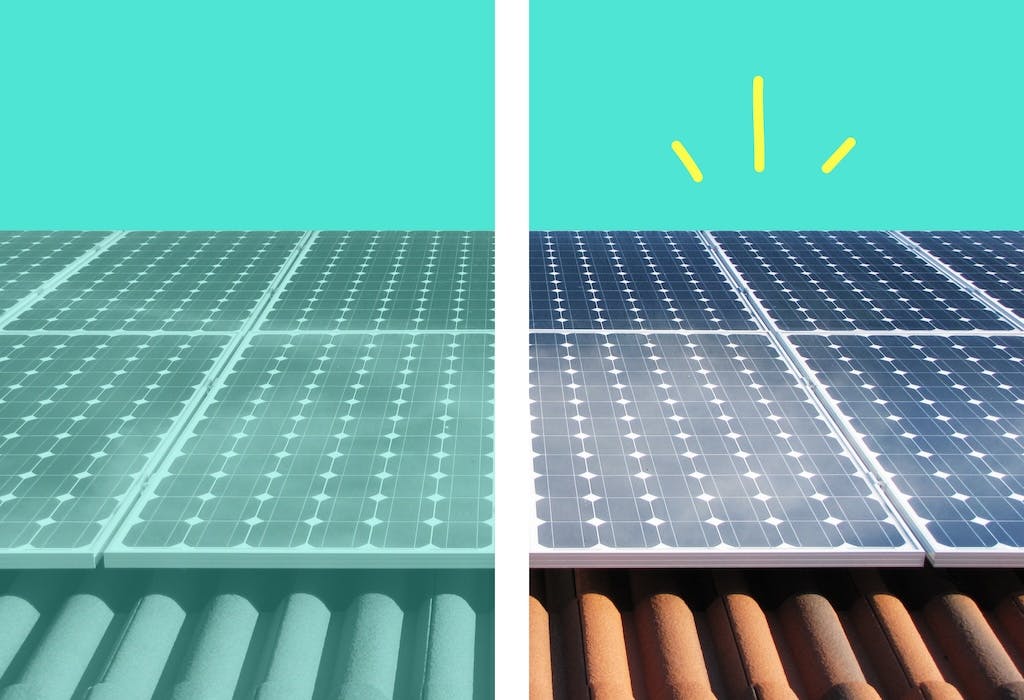- Solar advice hub
- Costs
- Rent-a-roof solar panels: what went wrong?
Rent-a-roof solar panels: what went wrong?
Here's how rent-a-roof schemes worked, what their main issues were, what caused their downfall – and the better alternatives.


Why you can trust our content
We know that the solar industry is full of misinformation, but we only use reliable sources, including:
- Our experienced solar experts, installers and system designers
- Our own database of solar & battery system designs
- Authoritative bodies like MCS and the UK government




Calculate savings
What kind of home do you live in?
Calculate savings
What kind of home do you live in?
Rent-a-roof schemes: at a glance
Rent-a-roof schemes provided free solar panels to households all over the UK during the 2010s – but there were plenty of strings attached.
They stand in contrast with current-day solar subscription services like Sunsave Plus, which allow you to retain control of your roof, your solar panel system, and your future.
In this guide, we’ll explain how rent-a-roof schemes worked, what their biggest issues were, and what caused their downfall – plus the better alternatives that grew in their place.
If you would like to see how much you could save by getting a solar & battery system at no upfront cost without entering a rent-a-roof scheme, just answer a few quick questions below and we’ll provide an estimate.
Find out how much you can save
What kind of home do you live in?
What were rent-a-roof solar panel schemes?
‘Rent-a-roof’ solar panel schemes were another name for solar installations that required a roof lease.
They exploded in popularity after the government introduced the Feed-in Tariff in 2010.
As well as giving these homes 3.2p per kilowatt-hour (kWh) for the electricity they sent to the grid – in the same way solar export tariffs do now – the Feed-in Tariff also paid households for all the electricity they generated.
Generation rates started out at 30-44p per kWh , which was extremely generous, especially considering the average home in the UK paid 12.6p per kWh for electricity in 2010.
Rent-a-roof schemes fell out of favour as the 2010s wore on, to the extent that it’s unusual to find one these days.
Their issues became obvious to customers (more on that below), and Feed-in Tariff rates fell dramatically in 2016 – making businesses much less keen to get involved – before closing to new applicants in 2019.
How did they work?
Rent-a-roof solar panel schemes required homeowners to give a solar company the rights to their rooftop or the airspace above it for up to 25 years.
That company would then install rooftop solar panels for free, in return for receiving the household’s Feed-in Tariff payments.
Once the lease ended, the homeowner could buy the panels, have them removed, or renew the lease.
It sounded like a good deal to thousands of households, but once the lure of free solar panels and forecasted energy bill savings of 50% convinced them to sign on, many realised their contract included unpleasant clauses.
Because the company owned the property’s roof, homeowners were often required to ask for permission to alter or sell their home – which could simply be refused.
If the homeowner did anything to lower the panels’ output – even if it was a temporary removal to make vital repairs to the roof – some contracts allowed the company to charge them for lost revenue.
While rent-a-roof companies sat back and enjoyed an average of £23,000 in Feed-in Tariff payments , numerous households were stopped from selling their properties or even exiting their contracts early.
Many of these leases from the 2010s are still ongoing, with end dates in the 2030s or 2040s.
It's also worth noting that solar roof leases are different to solar panel leases, which work a bit differently.

How popular were the schemes?
The great majority of homeowners who decided to go solar avoided rent-a-roof schemes, but they still attracted tens of thousands of households.
3% of solar panel owners entered into one of these contracts, according to a Which? survey of more than 2,100 people.
While the Feed-in Tariff was in effect, more than 900,000 homes in the UK had solar panels installed – so we can estimate that around 27,000 households signed up for a rent-a-roof scheme.

The UK's first solar subscription
- No upfront cost
- Fixed monthly fee
- 20-year Sunsave Guarantee
What were the problems with rent-a-roof solar panel schemes?
There were several problems with rent-a-roof solar panel schemes, most of which were impossible to solve after the contract had been signed.
Here are the main problems that affected rent-a-roof customers.
You didn’t own the solar panels
When someone signed over their roof to one of these companies, they gave up all rights to own the solar panels on their home until the end of the contract, at the earliest.
While rent-a-roof homeowners didn’t have to pay for the system’s installation, they also didn’t receive Feed-in Tariff payments from the government.
These payments included a ground-breakingly profitable generation tariff, which continues to earn thousands of pounds for solar panel owners who got their systems in the 2010s – except customers whose earnings all went to the company that owned their roof.
Export payments also went to this company, meaning the only benefit for these homeowners was energy bill savings.
This was unfortunate, particularly as the government funded the Feed-in Tariff by adding a small extra charge to every domestic energy bill, which was then returned to the people as a reward for going green – and the sums were substantial.
In the scheme’s first four years, the government paid out more than £700 million. In 2022/23, Feed-in Tariff recipients earned £1.73 billion.
This virtuous cycle – of money travelling from the people to the government and back again to encourage solar adoption – was interrupted by rent-a-roof firms.
By not sharing the Feed-in Tariff proceeds with the homeowner, rent-a-roof companies went against the spirit of the scheme.
You didn’t have full control over your property
This is the main reason why rent-a-roof contracts gained such a bad reputation in the 2010s – and with some justification.
When a homeowner handed over ownership of their roof space, they didn’t just give up that part of their home – in many cases, they also relinquished the ability to make significant changes to the entire property without the company’s permission.
Being able to get an extension, a loft conversion, or a new roof is one of the biggest advantages of owning your home – but many rent-a-roof customers had to get the company’s consent to move ahead with any of these alterations.
And if this permission wasn’t granted, homeowners had no recourse.
Even when rent-a-roof firms agreed to home improvements, some contracts enabled them to claim compensation for any missed export or generation payments resulting from the works.
And those weren’t the only harsh stipulations inflicted on customers. One rent-a-roof contract seen by Which? required the homeowner to get the company’s consent if they wanted to sell the property – and this wasn’t especially unusual.
You had difficulty selling your home
As well as some customers needing to get the company’s permission to sell their home, rent-a-roof schemes were also notorious for putting off potential buyers.
And who can blame them – after all, if you own a property, you want to be able to add an extension or loft conversion.
Buyers also often found it more difficult to secure a mortgage, with many providers unwilling to lend against homes with a rent-a-roof lease, since they can potentially be harder to repossess in a mortgage default scenario.
A customer interviewed by The Guardian in 2018 detailed how the agent in charge of their agreement only allowed them to sell their home after reporters intervened – and only after they bought the system.
The homeowner had to pay £20,500 – a hefty, uncosted amount that the agent said was non-negotiable.
A different customer who had retired with multiple sclerosis and myotonic dystrophy said her home’s prospective buyer wouldn’t move forward until she had her panels removed – but her contract forbade her from doing so until the lease expired in 2035.
And yet another homeowner couldn’t remortgage his property – and would likely find it hard to sell – because his lender said the rent-a-roof company that installed his panels had broken building regulations.
You may have been unable to exit the contract
Some rent-a-roof schemes didn’t include a buyout clause in the contract, which meant you were locked in until the end of the lease, with no other way out.
One of the people interviewed by the same article in The Guardian said her elderly father had signed up to a 25-year contract in 2011 that didn’t include a buyout option.
When her father’s roof started to leak, they were forced to pay a large amount for the panels to be taken off during the works, then put back afterwards.
Are rent-a-roof schemes still available?
Rent-a-roof schemes linked to Feed-in Tariff payments haven’t been available since the closure of the Feed-in Tariff scheme to new customers in 2019.
There are still solar installations that require a roof lease, though.
These arrangements are typically less restrictive and punitive than rent-a-roof contracts were, helped by the fact that mortgage lenders are more familiar and comfortable with roof leases now.
Some present-day solar leases provide a lot of benefits to homeowners, but it’s still worth watching out for these common issues:
- Unlike mortgage lenders, homebuyers may still not be willing to take on a solar lease, due to the negative reputation of rent-a-roof schemes
- You still won’t own your system, so it’s possible you won’t be able to receive the payments from your export tariff
- Leases can still restrict your ability to modify your property in ways that could affect the panels
- Some companies will try to include unreasonable terms and conditions, so read your contract carefully and don’t hesitate to raise objections
Thinking of signing up for a rent-a-roof scheme?
If you are still thinking about choosing a rent-a-roof scheme (or a solar product that requires a roof lease), there are several important questions you should check with your prospective installer:
- Will I earn export income?
- How will the product affect my ability to sell my property?
- What happens if I want to make any changes to my roof or build an extension?
- How will it affect the value of my home?
- How will the product affect my ability to renew my mortgage or change mortgage provider?
- Is the system fully insured?
- What happens to the solar panels at the end of the lease?
- Can I exit the contract early if I want to?
- Are there any additional charges?
If the answers to some of these questions are not what you want to hear, we recommend that you consider Sunsave Plus as an alternative. Our solar subscription is available at no upfront cost, and you legally own the system from day one (so any export income is all yours).
What’s more, you can end your subscription early at any point with a full repayment, and if you ever want to move home during your subscription, you can pass on the contract to the new homebuyer.
Every Sunsave Plus system is also backed up by the Sunsave Guarantee, which includes 24/7 monitoring, free replacement parts (including a battery and inverter), and downtime cover. Your system will also be insured by Aviva against damage, fire, and theft.
To find out more about what our customers think, check out our reviews page.
Find out how much you can save
What kind of home do you live in?
Rent-a-roof solar panels: FAQs
Related articles

Written byJosh Jackman
Josh has written about the rapid rise of home solar for the past six years. His data-driven work has been featured in United Nations and World Health Organisation documents, as well as publications including The Eco Experts, Financial Times, The Independent, The Telegraph, The Times, and The Sun. Josh has also been interviewed as a renewables expert on BBC One’s Rip-Off Britain, ITV1’s Tonight show, and BBC Radio 4 and 5.







